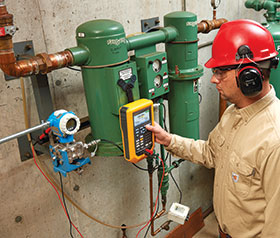

1. Performing pressure calibration when a slow leak is present
Performing a proper pressure calibration requires equipment and connectors that are dependable. With a leaking pressure source, keeping pressure stable at the calibration point long enough to take a reliable reading can be difficult. Slow leaks can require constant fine tuning through pressure adjustment applied from a pump, which makes it difficult for the system to settle. After the desired pressure set point is reached, it is recommended that systems settle for several seconds, or even minutes, prior to testing, so a more accurate and repeatable test result can be performed.
While slow pressure leaks caused by damaged hoses, worn fittings, or improper connections are common, there are several steps technicians can take to ensure a better calibration experience:
• Evaluate and debug pressure test systems before entering the field to reduce unnecessary trips back to the workshop.
• Try to decrease the number of pressure connections by using the correct hose length and removing extra fittings.
• Ensure that the test equipment is properly mounted.
• Mitigate leaks by using special-purpose test hoses.
2. Documenting pressure calibration requires multiple tools
Documenting pressure calibration results are important for the purpose of maintaining accurate instrument records, but the number of steps associated with the procedure can make the task difficult. For instance, a typical pressure calibration could require a pressure calibrator, pressure module or gauge for measuring pressure, a pump to generate pressure, and multiple hoses and fittings between the devices (including the connections to the pressure transmitter itself).
Before going to the field, not only do technicians need to prepare for specific calibrations by testing their setup and making sure the equipment is properly calibrated, they also need to carry all the appropriate test components with them. And before testing begins, technicians need to either write out the test procedure or fill in a method sheet. During the procedure, they must document the pressure being applied and the resulting current (mA) being measured, and then determine whether the unit under test passes or fails according to the determined criteria. If the unit under test fails, the technician will need to adjust the system as necessary and begin the testing procedure again.
Beyond having all the right components, the technician needs to ensure that the pressure measurement tool used is accurate enough to calibrate the transmitter or other device under test. The tools required and accuracy needed vary from one device to another, further compounding the difficulty. Special-purpose test hoses and connectors can make pressure connections easier and reduce the likelihood of leaks, eliminating one source of testing difficulty.
3. Manually generating and controlling the pressure for each test point
Pressure calibrations in process manufacturing environments rarely require testing to occur at a single test point. In fact, a typical pressure calibration can require anywhere from three to eleven pressure test points. Trying to adjust and fine tune system pressure for these specific points can be difficult and time consuming. Each individual point requires technicians to increase or decrease pressure by either pumping the system up or releasing pressure, and then to tune the pressure using the fine-adjust of the test pump.
This process can be simplified by carefully matching the selected hand pump to the pressure range of the transmitter being tested. For instance, some portable pneumatic pumps have pressure ranges that go up to 40 bar, but it can be difficult to increase pressure beyond 28 bar. There are, however, newer portable pumps that can easily be adjusted to over 60 bar if the primary calibration need requires higher pressure.
4. Achieving repeatability when calibrating a pressure switch
Calibrating a pressure switch can be a time-consuming task and repeatability is key to success. Achieving repeatability requires technicians to apply slow changes in pressure to the switch as it approaches its defined set or reset point. Not only do they need to determine where the switch sets, but they need to make sure that the fine adjustment mechanism of the test pump has the capability of varying the pressure up to set-point and then back to the reset point. Since these adjustments are manual, achieving repeatable measurements can be difficult.
With practice, technicians can get the fine adjustment of the pump within range of the set and reset point pressure with more regularity. This process can be further simplified by selecting a pump with a wide fine adjustment range, allowing you to more accurately make adjustments to meet your measurement needs.
The solution
The Fluke 729 Automatic Pressure Calibrator has been designed specifically with process technicians in mind for the purpose of simplifying the pressure calibration process while providing faster, more accurate test results. Technicians know that calibrating pressure can be a time-consuming task, but the 729 makes it easier than ever with an internal electric pump that provides automatic pressure generation and regulation in an easy-to-use, rugged, portable package.
The ideal portable pressure calibrator, the 729 will automatically pump to the desired set-point by simply typing in the target pressure. Technicians can then use its internal fine adjustment control to automatically stabilise the pressure at the requested value.
For more information contact Comtest, +27 (0)10 595 1821, sales@comtest.co.za, www.comtest.co.za
| Tel: | +27 10 595 1824 |
| Email: | sales@comtest.co.za |
| www: | www.comtest.co.za |
| Articles: | More information and articles about Comtest |

© Technews Publishing (Pty) Ltd | All Rights Reserved